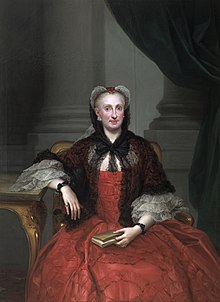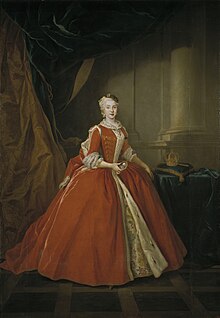Maria Amalia of Saxony
| Maria Amalia of Saxony | |
|---|---|
| Queen consort of Spain | |
 Maria Amalia of Saxony, posthomous portrait by Anton Raphael Mengs | |
| Burial | |
| Charles III of Spain | |
| Issue Detail | See Issue Link |
| House | House of Bourbon House of Wettin |
| Father | Augustus III of Poland, Elector of Saxony |
| Mother | Archduchess Maria Josepha of Austria |
Maria Amalia of Saxony, Queen Consort of Spain (24 November, 1724 – 27 September 1760) was a German princess from the House of Wettin and was the wife of Charles III of Spain; she was the Queen Consort of Naples and Sicily from 1738 till 1759 and then Queen Consort of Spain from 1759 till her death in 1760. Her descendants include today's King Juan Carlos I of Spain, Archduke Otto of Austria, Prince Henri, Count of Paris along with The Prince Napoléon as well as the two pretenders to the throne of the Kingdom of the Two Sicilies, Prince Carlo, Duke of Castro and the Infante Carlos, Duke of Calabria.
Biography
She was born at Zwinger Palace in Dresden, the daughter of Augustus III of Poland, Elector of Saxony and Maria Josepha, herself daughter of Joseph I, Holy Roman Emperor. Her full name was Maria Amalia Christina Franziska Xaveria Flora Walburga von Sachsen. One of 15 children, she was the sister of Frederick Christian, Elector of Saxony, Maria Anna Sophia of Saxony wife of her cousin Maximilian III Joseph, Elector of Bavaria; she was the older sister of Princess Maria Josepha of Saxony who was the mother of Louis XVI of France. Her youngest sister, Princess Kunigunde was a possible wife for the future Philippe Égailité.
Marriage

In 1737 Maria Amalia became engaged to the King of Naples and Sicily, the future Charles III of Spain. The marriage date was confirmed on 31 October 1737. In 1738, at the age of 14, Maria Amalia married Charles of Bourbon, then King of Naples and Sicily. Despite the fact that this was an arranged marriage, the couple was very close and had many children. Maria Amalia had a proxy ceremony at Dresden in May 1738 with her brother, Frederick Christian of Saxony representing Charles. This marriage was looked upon favourably by the Holy See and effectively meant the conclusion of the diplomatic disagreement Charles and the See had had.
The couple met for the first time on 19 June 1738 at Portella, a village on the frontier of the Kingdom near to Fondi.[1] At court, festivities lasted till 3 July when Charles created the Insigne e reale ordine di San Gennaro - the most prestigious order of Chivalry in the Kingdom. He later had the Order of Charles III created in Spain on 19 September 1771.
Maria Amalia was a very cultivated woman; she played an important role in the construction of the Caserta Palace for which she saw her husband lay the foundation stone for on his 26th birthday, 20 January 1752 amid much festivity; she also had much influence in the construction of the Palace of Portici (Reggia di Portici), the Teatro di San Carlo - constructed in just 270 days - the Palace of Capodimonte (Reggia di Capodimonte); her husband also had the Royal Palace of Naples renovated. Her apartments at Portici were home to the famous porcelain from the Capodimonte Porcelain Manufactory which she who introduced the production of Porcelain in Naples in 1743. She was also a heavy tobacco smoker. Maria Amalia was also a patron of the composer Gian Francesco Fortunati who was a favourite at the Neapolitan court.
At the end of 1758, Charles' half brother Ferdinand VI was displaying the same symptons of depression that his their father used to suffer from. Ferdinand lost his devoted wife, Infanta Barbara of Portugal in August 1758 and would fall into deep morning for her. He named Charles his heir on 10 December 1758 before leaving Madrid to stay at Villaviciosa de Odón where he died on 10 August 1759.
At that point Charles was proclaimed the King of Spain under the name of Charles III of Spain; in respect of the third Treaty of Vienna, which stated should he become King of Spain he would not be able to join them to the Neapolitan and Sicilian territories. He was later given the title of Lord of the Two Sicilies.
-
Maria Amalia's mother Maria Josepha of Austria in 1737, the year before her marriage to Charles of Naples and Sicily
-
Charles III of Spain, her husband in the year of her death, 1760
-
The Palace of Capodimonte (1880) in Naples which Maria Amalia lived; the Porcelain factory she founded was opposite the Palace
That same year they left Naples for Madrid, leaving two of their children behind in Caserta. Her third-surviving son became Ferdinand I of the Two Sicilies, while his elder brother Carlos was groomed in Spain to inherit the Spanish crown; their oldest brother, Infante Felipe, Duke of Calabria was mentally retarded and was thus taken out of the line of succession to any throne; he died quietly and forgotten in Portici where he had been born in 1747.
The right of succession to Naples and Sicily was reserved for her second son Prince Ferdinand of Naples and Sicily; Prince Ferdinand would stay in Italy while his parents were in Spain. In favour of that, Charles would abdicate on 6 October 1759, decreeing the final separation between the Spanish and Neapolitan crowns. Charles and his wife arrived in Barcelona on 7 October 1759.
In Spain her husband did much to improve the Spanish economy and helped give the contry more of an identiy. Maria Amalia once again did much to improve the royal residences having them redecorated. She, along with her husband, helped with the founding of the luxury porcelain factory under the name Real Fábrica del Buen Retiro.
In September 1760, a year after arriving in Madrid, Maria Amalia died from tuberculosis at the Buen Retiro Palace outside the capital. She was buried at the Royal Crypt in El Escorial. She was joined by her devoted husband in 1788.
In 1761, Charles commissioned Giovanni Battista Tiepolo to paint frescoes for the Royal Palace in Madrid. In the Queen’s Antechamber, Tiepolo and his assistants painted the Apotheosis of the Spanish Monarchy. The frescos were painted from 1762-1766. Queen Maria Amalia appears surrounded by several of the gods of Greek mythology, including Apollo.[2]
Prince Ferdinand became King of Naples and Sicily, at only eight years old, under the name of Ferdinand IV of Naples and as Ferdinand III of Sicily; in order to consolidate the alliance with Austria, he was destined to marry an Archduchess of Austria. Charles left his son's education and care to a Regency Counsel which was composed of eight members. This counsel would govern the countries until the young king be 16 years old. The Archduchess came in the form of Maria Carolina of Austria. The two would have 18 children.
| Spanish Family of Maria Amalia in 1743 |
|---|
 |
Issue
Ancestry
Titles, styles, honours and arms
| Styles of Maria Amalia, Queen of Spain as consort | |
|---|---|
| Reference style | Her Majesty |
| Spoken style | Your Majesty |
| Alternative style | Ma'am |
Titles and styles
- 24 November 1724 - September 1733 Her Highness Duchess Maria Amalia of Saxony
- September 1733 - May 1738 Her Royal Highness Princess Maria Amalia of Saxony, Duchess in Saxony, Princess of Poland and Lithuania etc
- The change of style was due to her fathers accession as King of Poland thus making her a "princess" by rank but not by birth;
- May 1738 - 10 August 1759 Her Majesty the Queen of Naples, Sicily and of Jerusalem, etc. Infanta of Spain, Duchess of Parma, Piacenza and of Castro etc.[4].
- 10 August 1759 – 27 September 1760 Her Majesty the Queen of Spain, the Queen of Naples, Sicily and of Jerusalem, etc. Infanta of Spain, Duchess of Parma, Piacenza and of Castro etc.
References
- ^ Harold Acton, I Borboni di Napoli (1734-1825) , Florence, Giunti, 1997.
- ^ [1]
- ^ House of Bourbon-Two Sicilies
- ^ Liste des décrets sur le site du ministère de la Culture espagnole.
Titles
| Titles and succession |
|---|
|
Template:House of Bourbon, 1700-1833 (Philip V-Ferdinand VI Arms) |





